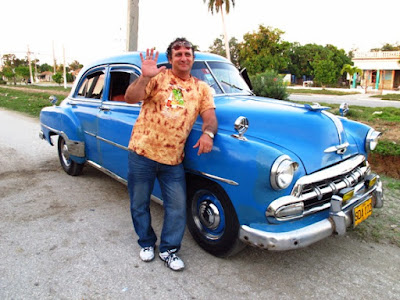 |
| 1950s vintage cars are still a big attraction for tourists to Cuba. We rode to dinner at a paladar in this blue Ford. |
 |
| Horseback or horse-drawn cart are primary means of travel in rural areas. |
Our travels covered more than 1100 miles during which we realized that Cuba is a country with contrasting landscapes: rugged mountains, lovely beaches, and green valleys in addition to bustling cities and remote rural areas where not much has changed since the 1950s.
Keep in mind, however, that if you visit by cruise ship, you'll get a very limited view of Cuba. As for other cruise ports, one or two days in Havana will hopefully whet your appetite to return and see more of this distinctive island country.
 |
| Beautiful sunset over the beach at Cienfuegos, a city of culture and history in Cuba. |
If Cuba is on your travel list it might be good to have a realistic idea of what you’ll discover there. Jessie, our Cuban guide summed it up this way: “Cuba is not a typical tourist place. I hope you brought a spirit of adventure and enjoy the people.”
Typical Cuban lifestyle
With that in mind, here are some facts of life that Jessie shared with our group:
 |
| The color of uniform worn by children indicates their grade level. |
People in public service careers like teachers, doctors, or engineers don’t get paid much. “One of worst things in Cuba is salary—what you need to live on versus what you earn is not balanced,” Jessie said. A doctor earns 25 CUC a month—roughly equivalent to 25 dollars (Jessie’s husband is a doctor). A carpenter or mechanic earns much more. Jessie estimated Cubans need about 300 CUC a month for living at a standard much lower than is typical in the U.S.
Cubans who work in tourism, as she does, work for the State but depend on tips for a living. For multi-lingual guides like Jessie, increased tourism means more American dollars (We tip well). Tips also support waitresses and bathroom attendants (keep those coins handy), who must have a license to do their jobs. “You have to have a license for everything,” Jessie told us.
 |
| The Vinales Valley is green, agricultural, and scenic. |
Hotels and restaurants are run by the government, which owns at least 51 percent of foreign properties (U.S. owned companies, for example). While private business is allowed in some cases, the State limits potential growth. “The State can close (take away a license) if it thinks a private business is getting too big. It may claim a lack of quality, even though private is usually better,” Jessie said.
 |
| This house, painted pink to grab attention, has a room for rent |
 |
| Each Cuban has a ration book noting provided monthly items. |
Cubans are issued ration notebooks at birth that stipulate the amount of staple food products they are allowed from the government each month. Per person examples: five pounds of rice, five pounds of brown sugar, three pounds of white sugar, half pound black beans, 10 eggs, one pound ground beef, and half a chicken. Most people shop at the first of the month because stores often run out.
 |
| Outdated farm equipment is still in use. |
Because items like matches, soap, shampoo, and toothpaste were removed from ration books a few years ago, they are very expensive. You'll see people on the streets hoping for a hand-out of such items. We brought personal care items to donate, along with school supplies, that were given to our guide to distribute where needed.
To hedge the high cost of many items like televisions and electronics Jessie told us, “Cubans use a lot of black markets. It’s a normal part of life. Everybody knows; nobody talks; everybody buys.”
As you can see, normal Cuban life is very different from that in the U.S., despite the fact it's barely 90 miles from the Florida coast. Changes at that level will come slowly. The government is still a Communist dictatorship, a fact worth remembering.
Photos by Larry and Beverly Burmeier








1 comment:
Interesting article, thanks for sharing. I'd love to visit Cuba... one day I'll get there :-)
Post a Comment